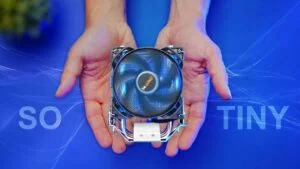How To Improve Your Gaming Mic Quality – The Difference Is HUGE!

Share:
I have a question for you, have you ever wondered what electromagnetic interference (EMI) inside your machine actually sounds like? Well put on some headphones and click here because you are about to hear it perfectly captured.
The Noise Problem
That EMI that you heard was actually recorded through the microphone of my gaming headset, which is the Massdrop X Sennheiser PC37X gaming headset. You can find a link for it down below in the description. It is one of my favorite gaming headsets of all time with a really beautiful natural sound microphone and I highly recommended it.
EMI is electromagnetic interference produced by your hardware, mainly by really powerful graphics cards, which is why we are able to hear it through the recording of the microphone. I started to wonder, how does EMI on different machines affect this particular microphone? The microphone on the PX37X is quite sensitive so we can hear what’s happening inside the machine and we will be able to hear the difference between our various configurations. Also, if you’re interested in the comparison of actual audio quality between different devices from motherboards to expensive amplifiers we have done that testing too.
The idea to do this experiment really evolved through me testing multiple gaming headsets throughout the years on different machines and actually realizing that the microphone quality is slightly different from one system to another. In this article let’s test out how this PC37X microphone sounds based on different sources, specifically my ThreadRipper machine, my external USB sound card, my Corsair ONE, and my Razer Blade 17. In this article, I will provide some guidelines on how to improve audio quality as well, so you will be able to pick up some tips on how to make that noise disappear and also make your microphone sound much better.
Noise Floor
The first thing I wanted to establish is a noise floor, so you can hear the difference between all these machines by muting the microphone and boosting the gain to maximum so we can hear what the noise floor sounds like without any variables introduced. This background hiss comes from different hardware components within whatever audio configuration, so my ThreadRipper machine and the Corsair ONE both have the same codec from Realtek, but obviously different motherboards. The ASUS motherboard in my ThreadRipper system actually has dedicated EMI shielding on the audio subsystem to remove any potential interference, and that consists of a metal cover/shield and having the audio section physical from the main motherboard area.
The Sound Blaster X3 is a USB external sound card, so none of the EMI that normally happens around the motherboard is actually effecting this unit. The Razer Blade 17 is probably the most challenging to make sound clean, just because all the components are crammed in such a tiny chassis, so shielding that would be quite difficult. The most interesting thing to observe here is just how the noise floor changes based on system load. For example, when the GPU is at 100% that is when EMI kicks in and you can hear that through the microphone. Click here to listen to the noise samples for the four setups.
If you listened to the four samples it is pretty clear that the Sound Blaster X3 external USB sound card was the cleanest. That wasn’t a surprise given that it’s far away from all the EMI emitting hardware, and the only background hiss or noise is produced by the USB bus or its own internal power supply. However, there are a few surprises here. For starters, the Corsair ONE and the ThreadRipper machine both have the same codec – but different motherboards – and it was amazing how much quieter the Corsair ONE machine was even. Even though they are both running a RTX 2080 Ti, which is supposed to spew out so much EMI. Surprise number 2 is that there was a slight increase in interference when the GPU load was at 100% in all scenarios, except for the Sound Blaster. And surprise number 3 is just how dirty and noisy the microphone signal was on the Razer Blade 17, which is probably why you would want to invest ion an external DAC/amp combo.
Microphone Noise
The second part of my testing includes actually hearing what the microphone sounds like through a vocal projection in order to see if there is any noticeable difference between these machines. I wanted to start this test at zero dBa boost just to hear what the preamps are doing in order to amplify that vocal signal. Starting with my ThreadRipper machine with the ASUS Zenith Extreme Alpha motherboard and this has the loudest vocal pickup out of anything, so you don’t necessarily need to boost it to get good clarity on the vocals. However, if I add 10 dBa my speech is much louder without introducing too much of that background hiss. Moving on to the Sound Blaster X3, by the default it sounds a little bit too low, but it does give me a bit more natural vocal character versus my ASUS motherboard. If I boost the microphone through Command Center and lower the microphone gain this is my desired device for voice recordings. The microphone is boosted with a slightly lower gain that gives us that middle ground of it not being too harsh and not too quiet without raising the noise floor. Given the noise floor is already very quiet with this unit you probably don’t hear anything in the background aside from my AC running.
Moving onto the Corsair ONE, you can immediately hear that that is pretty quiet, which is why it actually got such good result in my noise profile test in the beginning. The preamps on this MSI Mini-ITX motherboards are not as powerful as what I have with my ASUS motherboard, so I have to boost the signal 20dBa inside the Realtek software so you can have a proper vocal projection. In doing so we raised the noise floor and also there is a bit of compression happening with my voice that I wasn’t hearing with the Sound Blaster X3, nor the ASUS motherboard. And finally the outlier, the Razer Blade 17, this one is once again pretty quiet on the preamps so we have to boost the signal in order to get the audible vocal speech. Boosting the signal is absolutely necessary, but it does introduce a lot more hiss and background noise versus all other machines.
Overestimated The Issue
After having listened to all the audio clips, I kind of came to the conclusion that noise in the background and hiss really doesn’t matter. Even with the Razer Blade 17, which has the noisiest microphone signal, if you have literally anything playing in the background you won’t necessarily be able to hear the microphone hiss or the noise. The main significant difference between all these machines would be the sensitivity of the initial pre-amplification of the microphone without adding any gains. My ASUS ThreadRipper motherboard has the best volume pickup without needing to boost anything, while all the other machines were kind of quiet and required some sort of amplification. However, even when boosting the signal, the hiss and noise will not matter whatsoever, especially in any gaming scenario.
Voicemeeter Banana
I recently discovered a free application to improve microphone quality called Voicemeeter Banana. First of all, it gets you more precise sensitivity adjustment, which is great. With a simple slider you can add a little base to the sound, which most gaming microphones lack. The PC37X microphone sounds pretty damn good with Voicemeeter Banana running in the background. The really important function here is called Noise Gate, which is much better than your traditional noise cancellation through Realtek drivers or your motherboard drivers. What Noise Gate does is it limits the volume at which the microphone starts to be picked up, so by playing around with little adjustments you can see when the microphone gets cut off. Depending on your volume of speech you can make it sound really good while it’s trying to isolate everything that isn’t at that certain volume level. Of course, this is also advantageous for streamers who use a headset microphone that generally doesn’t sound very smooth or pleasant. I’m really happy that I found out about this program because it makes the PC37X sound so much better.
Conclusion
The takeaway from this entire noise experiment is that it’s not as important as I thought it would be. Even in a gaming scenario where people are hearing you speak and there his background hiss coming from your side of things it will most likely be completely muted out by the gaming sounds and whatever other background noise there is. However, if background hiss and noise are a problem in your communications make sure to download this Voicemeeter Banana app. It is free, and all you need to do is play around with the Noise Gate and tweak the EQ a little to add some bass to make it sound more full and eliminate some of that noise
Voice Meter – https://bit.ly/3ict7NV
Buy items in this article from Amazon & other partners at the links below:
Drop PC37X Headset – https://massdrop.7eer.net/jGN3eSound Blaster X3 – https://geni.us/SBX3
Corsair ONE a100 – https://go.corsair.com/a100Corsair ONE i200 – https://go.corsair.com/i200
Check out the XPG Xenia Gaming Notebook – https://geni.us/XPGXENIA






































